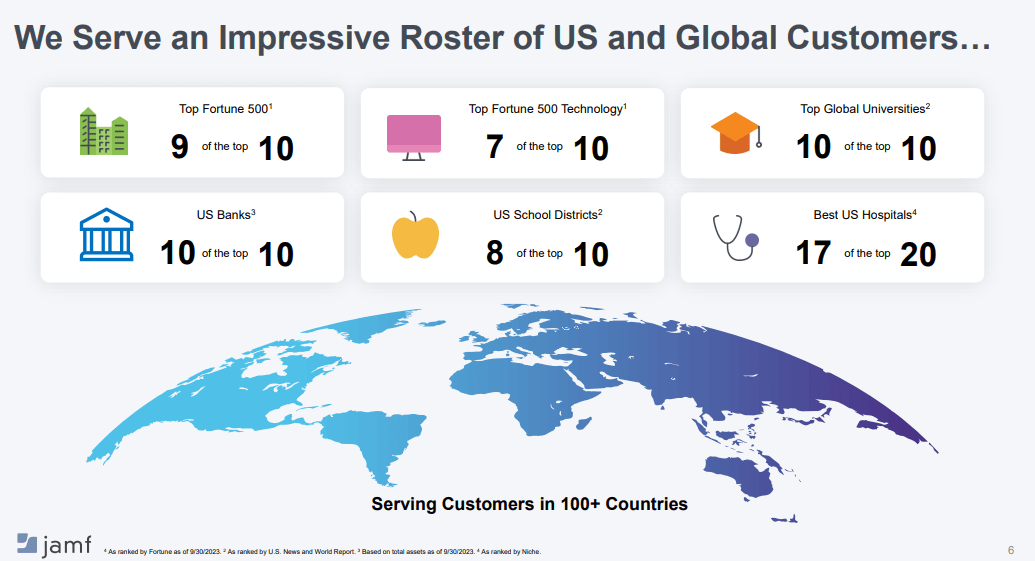Updates: JAMF 3Q23 - Apple Leader With Catalysts Coming

Summary
- JAMF is a company that has been sensitive to the declining economic climate, though the NTM outlook is positive thanks to expected refresh cycles.
- We discuss why MDMs are important, why Apple penetrating the corporate environment is a long-term tailwind, and why JAMF is far superior as an Apple-first MDM and security vendor.
- JAMF's valuation indicates a notable margin of safety over the long-term, though in the near-term there could be further downside until next year's catalysts kick in.
Executive Summary
At the current multiple levels, JAMF's stock provides a good margin of safety viewed from both relative and absolute perspectives. Multiples are currently suppressed due to JAMF being unable to offset declining growth with increases in profitability. JAMF is highly sensitive to the decline in hiring, especially the slump in the tech sector, which has severely impacted its Net Dollar Retention, which in turn has slowed down the number of new devices installed, hurting both growth and operating efficiency. JAMF is also feeling the aftermath of an oversupply environment of Macs and iPads following the resolution of the supply disruptions last year, leading to reduced demand during the past few quarters.
As management appears to be more resolute in improving operating efficiency going forward, JAMF's appeal to investors should improve. The base case is growth maintains or slightly improves thanks to the recent launch of the M3 Macs, pre-M1 Mac refreshes, and the expected iPad refresh cycle for the education sector (in 2H24). The bull case would be the macro improving also, whereby customers begin hiring again and increasing the number of devices under JAMF's management. However, as shown in the valuation section, even the bear case provides upside from the current valuation level.
JAMF Intro
Established in 2002, JAMF specializes in creating software that allows IT administrators to set up and automate processes, such as configure settings, installing apps, etc., for Apple device fleets within organizations. Initially concentrating on Mac PCs, JAMF has expanded its offerings to include iPhones, iPads, Apple TVs, and even Apple Watches, encompassing the full range of Apple's product line in its Mobile Device Management (MDM) solutions. In recent years, the vendor has added security to their device management capabilities, protecting endpoints and providing Zero Trust access to applications.
With over a decade of experience in managing Apple products in the business sector, JAMF also offers substantial support for managing and resolving Microsoft and Google related tasks and issues. In 2017, the company saw a significant development when Vista Equity Partners, a software-focused private equity firm, acquired a majority interest. This acquisition has enabled JAMF to capitalize on its Apple management expertise, leading to revenue growth and profitability.

JAMF now has a number of products for both managing and securing Apple devices. The management products are differentiated by market segment, whereby they have JAMF Pro, JAMF Now, and JAMF School, respectively for the enterprise, SMB, and education segments.

JAMF's security capabilities can be divided into endpoint security (detection & response), web threat prevention (aka Secure Web Gateway, or SWG), and Zero Trust Network Access (ZTNA). JAMF also provides slick authentication experiences by enabling users to verify themselves with Face or Touch ID when accessing corporate resources. Below are the products that encompass these security and access capabilities.

Key competitors to JAMF include generic or Windows-centric players such as Workspace ONE (owned by VMware), Citrix, and MobileIron (owned by Ivanti). These large-scale rivals are Windows-centric but also offer Apple and Android MDM services. Smaller players such as Mosyle, Addigy, and Kandji are Apple specialist MDM vendors like JAMF, but have narrower platforms and lower revenue levels. JAMF has a huge installed base of 71k customers, and boasts the largest enterprises in the world as its customers.

The Need for MDM
MDM software, exemplified by providers like Jamf, is essential for efficient ement of device fleets. Traditionally, managing an array of employee devices (PCs, laptops, tablets, phones, etc.) demanded extensive manual labour, whereby IT needed to physically handle these devices. Tasks such as setting up devices, software installations, updates, and bug fixes were repetitive and time-intensive, with individual employee issues further escalating costs.
MDM vendors simplify this process, allowing remote, automated, and scalable device management. It enables mass software installations and configurations with minimal effort (e.g., updating WiFi credentials on thousands of devices simultaneously). Priced around $14 per device, Jamf offers significant cost-effectiveness when one considers idiosyncratic employee issues alone could cost $100 per year (assuming three helpdesk tickets per year and resolution for one issue taking an IT administrator one hour to complete).



